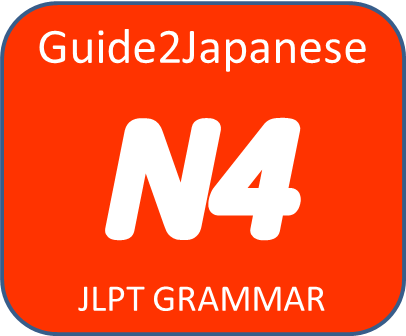JLPT N4 GRAMMAR: ~てあります (~tearimasu)
Meaning: In the state of …. [….(स्थिती) हुआ है]
~てありますform indicates the state which results as a consequence of an action intentionally done by somebody.
Formation:
動詞て形+あります
Example sentences:
- 机の上にメモが置いてあります。
- Tsukue no ue ni memo ga oite arimasu.
- There is a memo put on the desk.
- डेस्क पर मेमो रखा हुआ है।
- カレンダーに今月の予定が書いてあります。
- Karendā ni kongetsu no yotei ga kaite arimasu.
- This month’s schedule is written on the calender.
- कैलेंडर पर इस महीने के कार्यक्रम लिखा हुआ है।
- 「メモはどこですか。」「…メモは机の上に置いてあります。」
- `Memo wa dokodesu ka.’`… Memo wa tsukue no ue ni oite arimasu.’
- “Where is the memo?” ” It’s been put on the desk.”
- “मेमो कहाँ है?” “… मेमो डेस्क पर रखा हुआ है।”
- 今月の予定はカレンダーに書いてあります。
- Kongetsu no yotei wa karendā ni kaite arimasu.
- This month’s schedule is written on the calendar.
- इस महीने का कार्यक्रम कैलेंडर पर लिखा हुआ है।
- ホテルはもう予約してあります。
- Hoteru wa mō yoyaku shite arimasu.
- I have already reserved the hotel.
- होटल पहले से ही बुक कीया हुआ है।
- 誕生日のプレゼントはもう買ってあります。
- Tanjōbi no purezento wa mō katte arimasu.
- I have already bought a present for the birthday.
- पहले से ही जन्मदिन का तोहफा खरीदा हुआ है।
The difference between the ~ています&~てあります is as below.
- 窓が閉まっています。
- Mado ga shimatte imasu.
- The window is closed.
- खिड़की बंद है।
- 窓が閉めてあります。
- Mado ga shimete arimasu.
- The window has been closed (for some purpose).
- खिड़की बंद कर दिया हुआ है।



